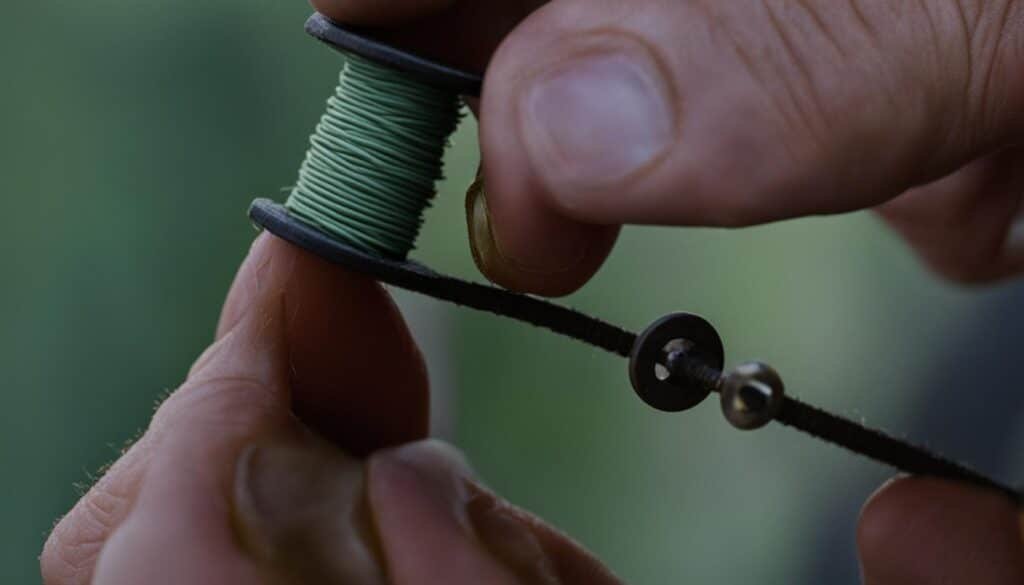Are you ready to take your bass fishing skills to the next level? If so, mastering the Carolina rig is the fishing technique you need to know. The Carolina rig is a versatile and effective method for targeting bass, especially in cold water and murky conditions. By understanding the setup, selecting the right fishing gear, and using the proper fishing lure, you can increase your chances of success on the water.
Unlike the Texas rig, the Carolina rig setup positions the weight differently, creating a unique circular motion as the lure drops or encounters current. To get started, you’ll need basic fishing gear such as a medium-heavy rod, beads, swivel, hooks, leader line, reel, and sinkers. With these essentials in hand, you’ll be well-equipped to conquer the bass fishing world with the Carolina rig.
So, get ready to dive into the details of the Carolina rig setup, understand its advantages in different conditions, learn how to assemble the rig, and discover tips for fishing success. Plus, we’ll provide you with insights on selecting the right baits and weights, fine-tuning the presentation, and identifying optimal fishing conditions. By the end of this article, you’ll have the knowledge to confidently use the Carolina rig for bass fishing success.
Understanding the Carolina Rig Setup
The Carolina rig setup is an essential technique for successful bass fishing. Unlike the Texas rig, the Carolina rig’s weight position is fixed above the lure, creating a unique circular motion as the lure drops or encounters current. This motion helps attract bass by mimicking natural baitfish movements.
The weight used in the Carolina rig can vary depending on the target species and water conditions. It can be as heavy as 2 ounces or more for deep-water fishing or fishing in strong currents. The weight plays a crucial role in determining the depth at which the lure will sink and how quickly it will reach the desired zone.
The leader length is another important aspect of the Carolina rig setup. The leader is the line that connects the weight to the lure. It allows the lure to move freely while maintaining distance from the weight, enhancing its natural presentation. The length of the leader line can range from 12 to 48 inches, depending on the depth at which the fish are located. Longer leaders are typically used when fishing in deeper water.
When assembling your Carolina rig, make sure to use appropriate fishing gear. A medium-heavy rod is recommended for optimal control and casting distance. Ensure you have all the necessary components, including beads, a swivel, hooks, leader line, reel, and sinkers. These elements work together to create an effective Carolina rig setup that increases your chances of catching bass.
Advantages of the Carolina Rig in Different Conditions
The Carolina rig offers several advantages that make it a highly effective fishing technique in various conditions.
In Cold Water Fishing
One of the key advantages of the Carolina rig is its effectiveness in colder water conditions. During the spring and late fall or early winter, bass tend to prefer warmer waters on the bottom. By using the Carolina rig, you can easily weight down your rig to reach the colder bottom areas where the bass are located. This allows you to present your bait in the most favorable position and increases your chances of enticing a bite.
In Murky Water Fishing
The Carolina rig is also well-suited for fishing in murky water. When the water is cloudy and visibility is limited, bass tend to be more active and move around a lot. The Carolina rig’s ability to cover extra distance and create a natural presentation makes it ideal for attracting bass in these conditions. By utilizing the circular motion of the rig, you can effectively mimic the movement of prey and grab the attention of bass that are actively feeding and searching for food.
Assembling the Carolina Rig
Assembling the Carolina rig is a simple process that requires a few key components. Follow these steps to put together your Carolina rig:
- Start by attaching your bait, preferably a soft plastic lure, to an offset worm hook. Make sure to choose a hook size that matches the size of your bait or lure.
- Next, connect the leader line to the hook. The length of the leader line can vary from 12 to 48 inches, depending on the depth at which the fish are located.
- Use a swivel to connect the other end of the leader line to the main fishing line. The swivel serves as a connection point between the two lines and allows for smooth movement.
- Now, slide a bullet weight onto the main fishing line. The weight helps to create the necessary casting distance and provides stability to the rig.
- Below the weight, add a bead. The bead acts as a buffer between the weight and the swivel, preventing any potential damage or interference.
- Finally, attach the main fishing line to the swivel to complete the rig assembly. Make sure all the components are securely connected and ready for action.
Now that you’ve assembled your Carolina rig, you’re ready to hit the water and start fishing.
Tips for Fishing with the Carolina Rig

The Carolina rig is a highly effective fishing technique that requires some specific tips and techniques to maximize your success. Here are some valuable tips to help you make the most of your Carolina rig fishing:
- Slow Presentation: The Carolina rig works best when presented slowly. Crawl the bait along the bottom, making subtle movements, and incorporate long pauses to entice the bass. This slow presentation mimics the natural movement of prey and increases your chances of getting a bite.
- Rod Positioning: To optimize line movement during the sweeping motion, many anglers prefer using a rod length of at least 7 feet. This longer rod allows for better control and sensitivity, enabling you to feel the bottom structure and detect subtle strikes more effectively.
- Pay Attention to Bottom Composition: As you move the Carolina rig along the bottom, pay close attention to the composition of the bottom. Different structures, such as grass, sand, and gravel, can be felt through the rod. By understanding the composition, you can target areas where bass are likely to be hiding and increase your chances of success.
- Prespawn and Postspawn Periods: The Carolina rig is particularly effective during the prespawn and postspawn periods when bass are migrating along transition routes. During these periods, bass are actively feeding and searching for prey, making them more likely to strike your rig.
Selecting Baits for the Carolina Rig
The Carolina rig offers versatility when it comes to bait selection. You can choose from a variety of options that work effectively with this fishing technique. Soft plastic worms, creature baits, and finesse baits are popular choices for the Carolina rig.
Soft plastic worms with kinked prerigged bodies, straight worms, and creature baits such as Zoom’s Brush Hog or Yum’s Wooly Hawgtail are all excellent options.
When selecting your bait, consider the fishing conditions and the target species. The size and color of the bait should be matched accordingly. Different baits may attract different types of bass and other fish, so don’t be afraid to experiment and find the best combination for your Carolina rig setup.
Weight Options for the Carolina Rig
When it comes to the Carolina rig, the weight you choose can make a big difference in your fishing success. There are several weight options to consider, each with its own benefits and advantages.
Slip Sinkers
One popular choice for Carolina rig weights is slip sinkers. These are typically 3/4 or 1 ounce in weight and are separated from the bait and hook by a leader. Slip sinkers allow for easy movement and can help the bait stay in contact with the bottom, making it more enticing to bass.
Tungsten Weights
Another option to consider is tungsten weights. These weights are known for their density, which allows for better sensitivity and the ability to transmit signals about the bottom type. Tungsten weights are also more compact compared to other options, reducing the chances of getting snagged or stuck.
Brass Weights
Brass weights have gained popularity among anglers using the Carolina rig due to their unique sound and ability to create clicking sounds against rocks and beads. This can help attract bass and trigger a strike. Brass weights are available in various sizes and shapes, allowing you to choose the right one based on your fishing conditions and preferences.
Consider the Fishing Conditions
When selecting the appropriate weight for your Carolina rig setup, consider the fishing conditions, water depth, and the desired action. Heavier weights may be necessary for fishing in deeper waters or in strong currents, while lighter weights can be used in shallow or calm waters.
Experiment with different weight options to see which one works best for you and helps you achieve the desired action and presentation. Remember, the weight you choose will impact how the bait moves and behaves in the water, so it’s important to choose wisely.
Fine-tuning the Presentation with Additional Techniques
When it comes to Carolina rig fishing, fine-tuning the presentation can make all the difference in enticing bass to bite. By making modifications to the bead and swivel components, you can enhance the performance of your Carolina rig.
One modification that some anglers swear by is adding a brass collar between the sinker and the bead. This addition maximizes the clicking sounds produced by the rig, which can be particularly effective in deep clear water or shallow murky water. The subtle noise can grab the attention of bass and entice them to strike.
Another technique to consider is incorporating rattling lures into your Carolina rig setup. These lures are designed to create additional noise and vibrations, mimicking the sounds of injured prey and attracting bass from a distance. Experiment with different rattling lures to find the ones that work best for your fishing conditions and target species.
Remember, the key to success is to experiment and find what works best for you. Fine-tuning the presentation of your Carolina rig through bead and swivel modifications, as well as the addition of rattling lures, can significantly increase your chances of hooking that trophy bass.
Identifying Optimal Conditions for Carolina Rig Fishing

When it comes to Carolina rig fishing, understanding the optimal conditions can greatly increase your chances of success. One important factor to consider is the water temperature. Bass tend to prefer warmer waters on the bottom during the spring and late fall or early winter. These colder water temperatures create ideal conditions for using the Carolina rig technique.
In addition to water temperature, another factor to keep in mind is the behavior of the bass. The Carolina rig can be particularly effective in murky water conditions when bass are actively moving and feeding. This allows you to cover extra distance and attract fish that are actively searching for prey.
To determine when it’s best to use the Carolina rig, consider the behavior of the bass and their preferences for temperature and depth. By fishing in the optimal conditions, you’ll increase your chances of landing that prized bass.
Tips for Carolina Rig Fishing Success
To maximize your Carolina rig fishing success, there are a few key tips to keep in mind. First, consider using a medium-heavy rod with a softer tip for casting the rig and detecting soft bites. This combination will provide the sensitivity needed to feel even the slightest nibble and ensure a solid hookset.
Next, experiment with different sinker options to enhance your Carolina rig’s performance. Brass or tungsten weights are popular choices, as they create distinctive sounds and vibrations that can attract bass. The choice of sinker depends on the fishing conditions and the specific action you want to achieve.
When it comes to bait selection, choose options that suit the fishing conditions, target species, and mimic the natural prey in the area. Soft plastic worms, creature baits, and finesse baits are all compatible with the Carolina rig and can be effective choices. Take into account the size and color of the bait and adjust accordingly.
Finally, practice patience and maintain a slow presentation when fishing with the Carolina rig. This technique is most effective when the bait is crawled along the bottom, allowing the bass ample time to spot and strike. Take advantage of pauses during the retrieve to entice bites from hesitant bass.

